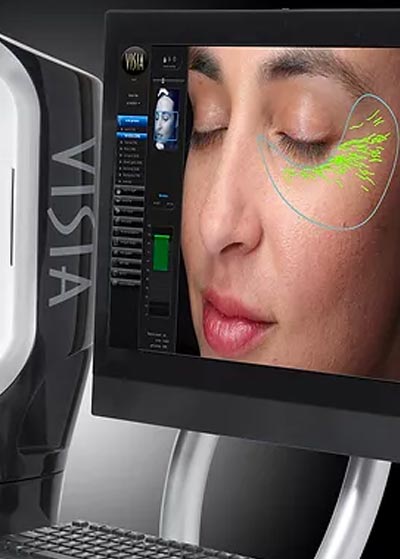VISIA® - Know the True Health and Age of Your Skin!
VISIA® Skin Analysis works by using an imaging machine coupled with software that measures the surface and subsurface features of your face to provide the deepest possible understanding of your skin. This allows Royal Centre of Plastic Surgery’s skincare specialists to understand what treatment and products will be best for your individual skin health needs.


VISIA® Uses Several Features to Identify Skin Features:
VISIA® uses multispectral photos of different wavelengths, including infrared light, to identify visible and invisible changes in the skin that may indicate skin issues.
The TruSkin Age™ system evaluates your skin based on the presence of:
- Sun damage just below the skin surface (Age Spots)
- Brown and red spots
- Enlarged pores
- Wrinkles
- Uneven skin texture (raises or depressions in the skin)
- Red areas, inflammation, spider veins
- Porphyrins – bacteria within pores that can lead to acne and skin blemishes
Age Spots (Sun damage): Age spots are traditionally caused by overactive pigment cells. Sunlight increases the production of natural pigment melanin that gives skin its color. Skin that has extended periods of sun exposure develops melanin that is clustered in high concentrations. The selective absorption of the UV light by the epidermal melanin enhances its display and detection by VISIA®.
Brown and Red Spots: Spots are typically benign brown or red skin lesions that also include: freckles, acne scars, hyperpigmentation, Melasma, lentigines and vascular lesions. Spots are easily identified by their distinct color and contrast from the base skin tone. Spots can vary in size and in most cases have a circular shape. Brown Spots specifically produce an uneven appearance to the skin and are easily detected in VISIA® by RBX.
Enlarged Pores: Pores circular surface openings of sweat gland ducts. When shadowing occurs, pores appear darker than the surrounding skin tone and are identified by their darker color and circular shape. VISIA® imaging distinguishes pores from various spots based on their size.
Wrinkles: Wrinkles are folds or creases in the skin, which can dramatically increase when exposed to the sun and are tied to decreasing skin elasticity. This skin feature is the most dramatic from image to image, patient to patient.
Texture: Texture is the analysis of skin smoothness. Texture measures skin color and smoothness by identifying gradations in color from the surrounding skin tone, as well as peaks (shown in yellow) and valleys (shown in blue) on the skin surface that indicate variations in the surface texture.
Red Areas: Red areas represent a variety of potential skin conditions: Rosacea, acne, inflammation and spider veins. Blood vessels and hemoglobin contained in the papillary dermis, a sub-layer of skin, give these structures their red color, which is detected by the RBX Technology in VISIA®. Acne spots and inflammation vary in size but are generally round in shape. Rosacea is usually larger and diffuse compared to acne, and spider veins usually are short, thin and can be interconnected in a dense network.
Porphyrins: Porphyrins are bacterial excretions that can become lodged in pores and lead to acne. Porphyrins fluoresce in UV light and exhibit circular white spot characteristics.
What Are the Benefits of VISIA®?
Skin is unique and skin treatments should be created specifically for your type of skin. There are many benefits to using VISIA®, including:
- Determining the effectiveness of skin treatment. VISIA helps your GraceMed skincare specialists to monitor skin’s progress and how effective the treatment plan is for your skin. Your GraceMed skincare specialists can then make changes or continue to monitor your skin health.
- VISIA can also detect hidden skin issues. The technology and image system have the ability to identify some skin conditions that may not be noticeable on the surface of your skin.
- Your GraceMed skin specialist along with the VISIA can help determine individualized skin care treatments and products tailored specifically for your skin health needs.
VISIA® Treatment Overview
Anaesthesia: None
Procedure duration: 10-15 min per consult
Pain level: 0
Recovery time: None necessary
Resumption of physical activities: Immediately
Frequently Asked Questions About VISIA® Skin Analysis
How does VISIA® measure skin conditions?
Issues such as wrinkles, texture, age spots, UV spots, pores, brown spots, red areas, melanin (pigment), porphyrins and blood vessels are measured with Visia Skin Analysis. Then, using specific data points, age and skin type, it is compared to the world’s largest database of skin features utilizing VISIA’s® patented software analysis.
Do I open or close my eyes during a VISIA® Skin Analysis?
UV flashes are usually intense during UV photos, we recommended that eyes be closed.
Why does VISIA® Skin Analysis measure porphyrins and what are they?
Bacterial excretions, called porphyrins, can become embedded in pores and lead to acne. Exposure to the sun can cause porphyrins to release singlet oxygen that can lead to the oxidation of lipids in the skin. This can promote skin-damaging cytotoxic lipid peroxides. Sun damage and porphyrins are closely connected.
Are my personalized VISIA® Skin Analysis results available online?
VISIA’s report containing the facial images recommended treatment and ongoing progress can be provided to patients. GraceMed provides patients access to the web portal and results after setting up user/pass information. GraceMed’s VISIA® technology is available for all patients and all skin types.
